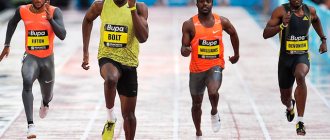Only strong-willed, strong, and resilient people can choose jogging as their main workout. Most often, competitions in this sport are held over distances ranging from forty to six hundred meters, which are considered small. But what is the correct technique for running short distances, in which an athlete can develop maximum speed and show the best results, correctly calculate his own strength, and reach the finish line in the first row? This is exactly what we will look into in our current article.
How did sprinting come about?
The first mention of running competitions dates back to 776 BC. According to the studied ancient records, there were two popular distances - running in the 1st and 2nd stages.
A stade is an ancient Greek unit for measuring long distances. One stadia equals 192.27 meters. It is interesting that stages were used only when determining the distance of running competitions, and for other measurements other measures of length were used.
If you make a little association, you can understand that the favorite running distances of the Ancient Greeks were 192.27 and 384.54 meters. In modern sports, distances have been brought to a more convenient format - 200 and 400 meters.
Over time, new types of running appeared, such as running half a stage or 6, 10 or more. That is, all distances known today in athletics occurred already in 776 BC. We are talking not only about short, but also medium and long distances.
Nutrition
Sprinters expend a lot of energy.
To replenish it, foods rich in proteins, carbohydrates and vitamins are required, and a runner needs to receive at least 4000 kcal per day.
Your daily diet should include foods such as:
Sources of vitamin A: carrots, red peppers, liver, butter.
Vitamin B1: nuts, spinach, beans, pork.
Rich in vitamin B6: peas, fish, rice, egg yolk.
Vitamin C: currants, lemons. oranges, rose hips.
Sources of calcium: dairy products, nuts, greens.
- Food should be taken 2-4 hours before the start.
- It is strictly forbidden to run on an empty stomach.
- During long training sessions, athletes lose a lot of fluid, so to prevent dehydration it is recommended to drink about 100 ml of water every half hour.
Athletes should avoid eating the following foods:
Sweet and fatty.
Fast food.
Roast.
Alcohol and energy drinks.
Sprinting technique
Features of the running technique in the discipline are the large length and frequency of steps. The main qualities that an athlete must have are maximum speed, speed endurance and coordination abilities. All technique in the sprint is divided into 4 stages: start and starting run, running along the distance and finishing.
Start
There are two ways to start at short distances: low and high start. Low start is carried out using special equipment - pads. The advantage of such a start is a faster exit from the start and a quicker increase in optimal speed.
The start is carried out according to three commands: start -> attention -> march. The “March” command is performed using a special pistol or by waving a flag.
The position of the athlete with a low start option: the pushing leg is in front, the swing leg is behind 1.5-2 feet from the heel in front. The head is lowered down, the shoulder girdle is relaxed. At the “Attention” command, the athlete transfers his body weight to the pushing leg. The pelvis rises to the level of the head. At the command “March” or a shot from a pistol, the sprinter performs a powerful push-off from the blocks and begins to pick up speed.
Starting run
After leaving the starting blocks, the sprinter takes 3 long strides. The body is directed forward, the head is lowered down and rises after 30-50 meters, when the athlete reaches maximum speed.
Distance running
Having gained maximum speed, the athlete raises his head and continues to maintain the momentum until the end of the distance. It is not recommended to look around to assess your position in the race. This can lead to reduced speed and loss of position.
It is worth paying attention to the shoulder girdle, which should be relaxed. Only the arms work, the shoulders remain relaxed. The torso tilt is 5-7 degrees, which promotes forward movement by inertia.
Finishing
The winner in sprinting is the athlete who touches the finish line first. If the finish took place in close competition and it is impossible to determine the order of arrival “by eye”, the judges use a photo finish.
When there is 1 meter left before the finish line, the athlete performs one of two special techniques: a chest throw or a sideways finish.
The chest throw consists of a sharp jerk of the chest forward, while the arms are pulled back. This increases the sprinter's chances of touching the finish line first.
The sideways finish has the same goals. Performed by turning the right shoulder towards the finish line.
The difference between the finishing jerk methods is relatively small. The use of one option or another depends on personal preference.
Safety regulations
The likelihood of injury directly depends on following (or not following) the established training methodology. It is necessary to observe the principle of gradualness when increasing the load and level of complexity of the exercises. You cannot overload the place of classes with a large number of students, or allow classes without the supervision of a teacher. Unsatisfactory condition of equipment, shoes, and clothing can lead to injuries. Read about running clothes and shoes here. It is not recommended to exercise in case of unfavorable weather conditions. You must not start exercises without the appropriate permission from a doctor, and also disturb public order during exercise.
To run 100 meters safely, the following general safety rules are in place:
- warm-up running is performed on the outermost track;
- you cannot prevent your opponents from starting;
- during a group start, you can only run in your own lane;
- when covering a distance, you need to look at the path;
- Having reached the finish line, you should continue moving for another 5-15 m, making room for the athlete running behind;
- during a break you cannot run 100 meters along the track against traffic;
- it is mandatory to clear the working distance;
- You need to return to the start along the outermost path.
It is not recommended to start training without a preliminary warm-up. The training area must be carefully inspected for safety - if there are any obstacles, they must be eliminated. Exercises are performed in accordance with the current capabilities and tasks of the sprinter; You should not lose control of your actions, especially when mastering complex techniques.
Male and female standards
There is a specially created document that indicates all the running standards for which you can get a rank. Below is a list of standards for men and women at distances of 50, 60, 100, 200, 300 and 400 meters.
- Men's short distance standards
Distance MSMK MS KMS Adult sports categories Youth sports categories I II III I II III 50 m — — — 6,1 6,3 6,6 7,0 7,4 8,0 60 m 6,70 6,84 7,04 7,34 7,64 8,04 8,44 8,94 9,54 100 m 10,34 10,64 10,94 11,44 12,04 12,94 13,64 14,44 15,44 200 m 20,75 21,34 22,24 23,24 24,44 25,84 28,24 30,74 34,24 300 m — — 34,74 37,24 40,24 43,24 47,24 53,24 59,24 400 m 46,00 47,35 49,65 52,15 56,15 1:00,15 1:05,15 1:10,15 1:15,15
- Women's short distance standards
Distance MSMK MS KMS Adult sports categories Youth sports categories I II III I II III 50 m — — — 6,9 7,3 7,7 8,2 8,6 9,3 60 m 7,30 7,50 7,84 8,24 8,64 9,14 9,64 10,14 10,74 100 m 11,34 11,84 12,54 13,24 14,04 15,04 16,04 17,24 18,24 200 m 22,94 24,14 25,54 27,04 28,74 31,24 33,24 35,24 37,24 300 m 40,0 42,0 45,0 49,0 53,0 57,0 — 40,0 42,0 400 m 51,20 54,05 57,15 1:01,15 1:05,15 1:10,15 1:16,15 1:22,15 1:28,15
You can receive a rank by showing the appropriate result in official competitions. Based on the result, the athlete receives a rank book, in which all received ranks will subsequently be recorded. Any standard that is met at competitions organized unofficially is not valid.
Types of short races
There is a single race and a relay race . Both types of sports discipline are performed over short distances. The relay event is a team competition discipline.
There are 3 variants of relay running - 4 segments of 100, 200 and 400 m. Single races at 60 m are held in indoor arenas and are not included in the Olympic program. For this type of running, the starting impulse is of decisive importance.
The classic version is the 100 m race. Competitions are held in open arenas and stadiums. The most prestigious athletics discipline, invariably included in the program of the Summer Olympics.
The next common sprint event is the 200 m race. Such competitions are held in indoor arenas and outdoor sports arenas. The segment is not covered in a straight line. It always has a smooth turn.
Sprinting is an athletic discipline that requires significant physical effort and a well-coordinated body.
In professional sports, doubles are common, when a record result is simultaneously achieved in 2 races at different distances. The 400 m race requires the correct distribution of forces throughout the entire distance. The last event is team relay races. The IAAF records record achievements in group races of 4 x 100, 4 x 200 and 4 x 400 m.
How to train?
In achieving results in sprint running, the quality of execution of technical elements is of great importance. However, even high precision movements do not provide good results. Therefore, when training sprinters, much attention is paid to physical fitness.
An athlete's maximum speed depends on the length and frequency of the stride. The optimal period for increasing step frequency is between 10 and 14 years of age. However, the frequency can develop after 14 years until reaching adulthood.
A popular exercise for increasing cadence is high-knee running. The idea is to perform 3-5 approaches with a time limit of 20-30 seconds. In a period of 30 seconds, it is necessary to perform the maximum number of movements, but not to violate the technique of the exercise.
Regular stretching after the main workout allows you to develop step length. It is also worth paying attention to the stride length when covering the sprint distance itself.
Benefit
Sprint running is not only a separate competitive discipline; athletes of various disciplines successfully include it in their daily training. This is due to the fact that this technique has a powerful effect on the entire body as a whole. The benefits of short-distance running are significant and have been confirmed not only by scientists, but also by the athletes themselves and their coaches:
- endurance and agility increase;
- coordination of movements improves;
- the lungs begin to work more efficiently, which means that organs and tissues begin to receive more oxygen;
- metabolism improves;
- muscle tone throughout the body increases;
- fats are intensively burned, which leads to weight loss;
- The entire cardiovascular system is trained, which helps to quickly adapt to heavy physical activity.









